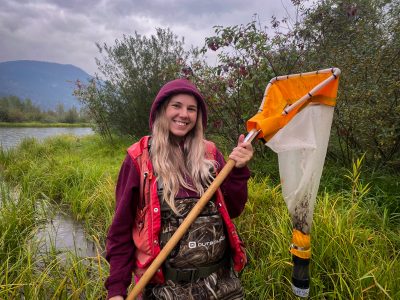WHAT IS CABIN?
The Canadian Aquatic Biomonitoring Network (CABIN) was created by Environment and Climate Change Canada (ECCC) as a collaborative initiative to assess freshwater ecosystem health throughout the country. It uses nationally standardized monitoring protocols, collecting benthic macroinvertebrate samples alongside hydrology, channel, habitat and water quality data to assess stream health. Benthic macroinvertebrates, the community of organisms that live in the substrates along the bottom of a river or stream, are indicators of aquatic health due to their high sensitivity to pollutants and climate change-related impacts.
PROGRAM SUMMARY
Living Lakes Canada was one of the first non-governmental organizations to be certified by the Canadian federal government to deliver field training for CABIN, a consistent and collaborative approach to assess aquatic ecosystem health that is mainly used for small to medium sized creeks.
Living Lakes Canada has been leading CABIN training courses across British Columbia and Canada for over 10 years. We offer private, location-flexible courses in CABIN field methods for Indigenous and non-Indigenous community-based water monitoring groups. These customizable training courses provide participants with background knowledge and hands-on practice with the CABIN protocol. Courses are led by our staff who are ECCC-certified CABIN trainers.
Benthic (bottom-dwelling) macroinvertebrates (small animals without a backbone) are collected by participants using the standardized 3-minute kick-net sampling method, demonstrated in the video clip below. Once collected, the benthics are sent to qualified taxonomists who then identify the type and number of organisms (family or genus level) present based on physical traits.
The data collected are uploaded to the national CABIN database for statistical analysis. In areas where reference models have been developed, the Reference Condition Approach (RCA) can be applied, comparing pristine/minimally impacted sites to sites under the influence of human activities. Abundance, richness and diversity metrics can also be compiled from the uploaded data by certified CABIN Project Managers to assess the condition of the site. Reports summarizing the statistical analysis conducted in the CABIN database can be output for users to assist in reporting on stream health and site condition.
PROGRAM GOAL
CABIN offers users the opportunity to assess stream health using standardized protocols and scientifically sound statistical analysis. Through proper application, CABIN offers an opportunity to understand how point-source and nonpoint-source pollution affects freshwater ecosystem health. Repeating sampling efforts over time allows users to measure the cumulative impacts, of changes in upstream land use, on the condition at the site. Scientifically rigorous, CABIN enables users to monitor and report on the condition of their sites in watersheds across the nation.
TRAINING
CABIN training entails the completion of online modules that focus on the theory and practices of using the CABIN protocol as well as a Field course to provide practical training and application of the techniques used for the collection of data in the field. The theory component of CABIN training is delivered by the Canadian Rivers Institute (CRI) through a series of online modules accessible once the participant is registered and has been provided user login details.
Starting in 2025, these online modules will be delivered directly through ECCC. We recommend everyone interested in CABIN training to complete both their field and theory component either before or after this transition. For further information, please refer to the official CABIN training website.
To learn more about CABIN training and to register through ECCC, please visit the CRI website. If, however, you are interested in hosting a private, location-flexible CABIN field training for a group of up to 12 people, please contact the Living Lakes Biomonitoring Team.
ADDITIONAL RESOURCES
Stay up to date with upcoming changes to CABIN training on the ECCC website.
Individual participants, please register on the CRI website.
CONTACT
To inquire about holding a Living Lakes Canada-led CABIN field training for your group or organization, please email us at biomonitoring@livinglakescanada.ca.

News and Updates
Measuring Water Heath with Bioindicators (pg. 24) – Water Canada Magazine, Mar/Apr 2024
Different ways the public participate in scientific research: Monitoring the health of streams with community-collected bugs – Canadian Science Publishing, Oct 12 2022
“It’s at the very core of everything”: The significance of Canada’s wild rivers – Canadian Geographic, June 2019
Wading into water concerns in the Bow Basin – High Country News, Dec 8 2022
Lower Fraser First Nations embrace biomonitoring to protect fish habitat – Living Lakes Canada, Nov 23 2022
Diving into STREAM/CABIN training in Fredericton, New Brunswick – Living Lakes Canada, June 23 2022






